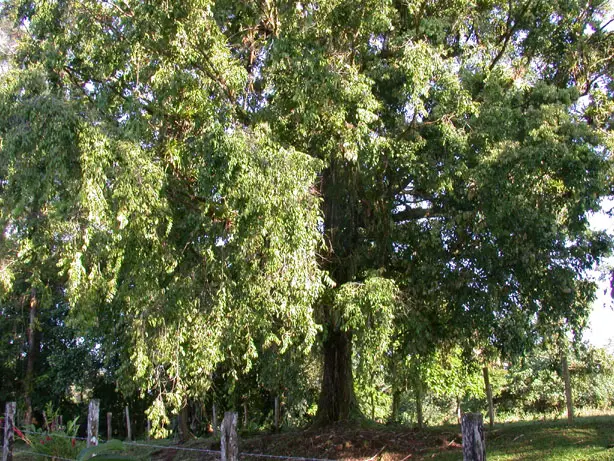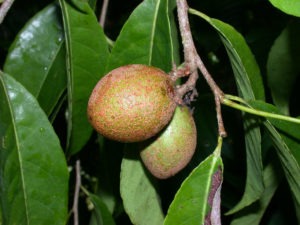Few studies have been conducted on the diet of the Great Green Macaw, and most of these are a compilation of information from sightings generated by people within the communities where the Great Green Macaw lives. Currently, in Costa Rica, up to 35 species have been reported as species the Great Green Macaw might feed on in small quantities. Among them, the Titor tree (Sacoglottis trichogyna) stands out as an important alternative food source to the Mountain almond tree (Chassot et al. 2004).

The Titor or Bell Tree is distributed from Nicaragua to Panama; in Costa Rica it is restricted to the Caribbean slope from the San Carlos plains to the Sixaola plains, between 20-500 meters above sea level and can usually reach 30-35 meters in height. (Florula Digital de La Selva, 2020).
In the Sarapiqui area and its surroundings it is common to see this tree as a remnant in pastures, intervened forests, or the margin of forest patches, etc. Its flowers can be seen in August and September and its fruits from February to April; its fruit is abundant and its seeds are dispersed by rodents such as Guatusas (Dasyprocta punctata), Tepezcuintles (Agouti paca), among others. And as we’ve mentioned above, it is also an important part of the Great Green Macaw’s (Ara ambiguus) diet (Florula Digital de La Selva, 2020).

The first records of this tree as a food source for the Great Green Macaw date back to the early 1990s, with the observations of Powell et al (1990), from which they realized that the Titor tree plays a very important role in the cycle of the Great Green Macaw in northern Costa Rica; when the production of food from the Mountain Almond tree decreases, the Titor appears as the second most important source of nutrients for these emblematic birds. Almost magically this impressive tree seems to complete a perfect feeding cycle in the life of young and adult Great Green Macaws.
In Costa Rica, habitat loss could be the main cause of the decline in the Great Green Macaw population. Studies conducted in the 1990s (Powell et al 1999) indicate that the population produced enough young to replace the adult population, however, this is not happening because, although there are enough young, there are not enough resources to sustain the population. This indicates that the greatest problem of the Great Green Macaw could be the lack of food resources, rather than the lack of nesting sites, which are provided in a 90% by the Mountain Almond Tree in the northern zone, the same tree that is protected by a logging restriction since 1996 given by the Costa Rican Forestry Law, N° 7575.
Although we protect the main source of nesting and one of the main food sources of the Great Green Macaw, the Mountain almond tree in the northern plains of Costa Rica, other great trees relevant to the Macaws, like the Titor, now suffers a similar fate than the Mountain almond has.
Since 1996, when the restriction to protect the mountain almond tree began, the loggers’ goal have changed drastically, severely affecting those other 35 species that provide food sources for the Macaws. One of the most affected species has been the Titor. According to our field observations, in the nesting area of the great green macaw in northern Costa Rica there is one Titor for every 10 Mountain almond trees.
This, we believe, is due to the resistance and hardness of Titor wood, which has come to replace the Mountain almond as a precious wood. But the tough, precious Titor isn’t the only tree in this situation, but also various other food sources that the Great Green Macaw frequents.
There’s a harsh reality regarding the availability of other food sources for the Great Green Macaw. We as an organization contribute a grain of sand to the restoration and protection of the habitat; currently, we have carried out reforestation projects in the north of Costa Rica, all of them with Mountain almond trees, and we hope that in the future we’ll be able to produce Titor as well, but the latter has a long and complicated germination process, and this makes the restoration strategy of this species especially difficult.


